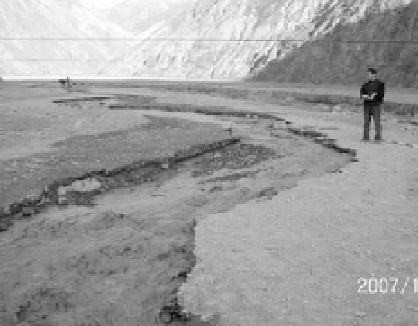Environmental Engineering Reference
In-Depth Information
shows that the ratio of bed load rate over stream power,
g
b
/
p
, reduces with increasing
S
P
.
Fig. 11.33
The ratio of bed load rate over stream power,
g
b
/
p
, as a function of the development degree of the
step-pool system,
S
P
11.2.2.3
Experiment on Development of Bed Structures
Bed structures play a similar role as bed load motion in creating resistance, consuming energy of the flow,
and protecting the bed material from erosion. Two kinds of experiments were done in the study. The first
kind of experiments was done in the Jiangjia Ravine, in which three experiments were conducted (Liu
and Wang, 2009, Liu et al., 2010). Figure 11.34(a) shows the experimental plot, which was on a debris flow
deposit on the left side of the Jiangjia Ravine. Figure 11.34(b) shows the first experiment in which the
water with loads flowed in the experimental channel and scoured the channel banks. After an intensive
fluvial process the channel gradually became stable and reached equilibrium.
(a) (b)
Fig. 11.34
(a) Experiment plot on the left side of the Jiangjia Ravine; (b) Water with loads flowed in the experimental
channel and scoured the channel banks. (See color figure at the end of this topic)
Figure 11.35(a) shows the original sediment size distribution of the experimental plot. The plot had
various types of sediment including: silt, sand, gravel, cobbles, and boulders. Fine materials were mixed
with cobbles and boulders, and, thus, the surface of the experimental plot looked smooth. The discharge
was controlled by a small dam on the Jiangjia Ravine which consisted of boulders, cobbles and gravel.
Figure 11.35(b) shows the flow discharge diverted into the experimental channel during the first experiment




Search WWH ::

Custom Search